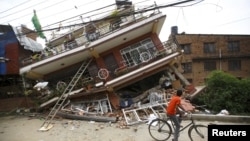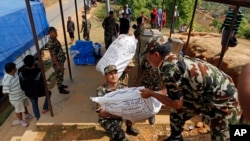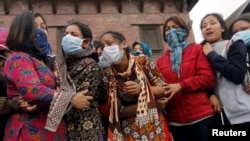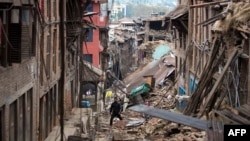An engineer with parents living in Zimbabwe is among thousands of foreigners stranded in Nepal, which was hit by a massive earthquake a few days ago that claimed the lives of over 4,300 people.
Michael Neumann, a resident engineer for Rasuwagadhi Hydroelectric Project, says the situation is dire in Nepal as rescue efforts are being hampered by lack of roads and shortages of rescue equipment.
Neumann, who holds a German passport and was educated at Zimbabwe’s Gifford High School in Bulawayo, tells Studio 7’s Gibbs Dube he is safe though worried about the current situation in that country.
Time is running out to find more survivors of Saturday’s huge earthquake in Nepal, which the country’s prime minister estimates could have killed 10,000 people.
But the effort to get critical support into the landlocked Himalayan nation has ironically been hampered by overwhelming generosity, which has inundated the only international airport.
Tribhuvan International Airport now resembles a military base with planes, helicopters, soldiers and airmen from numerous countries -- not all of them on good terms with each other -- converging here for a humanitarian cause.
Saturday’s magnitude 7.8 earthquake may have killed as many as 10,000 people, according to Prime Minister Sushil Koirala.
U.S. Ambassador Peter Bodde welcomed a USAID Disaster Assistance Response team (DART), part of an initial U.S. contribution of $10 million for aid in response to Nepal’s worst earthquake since 1934.
“The government of Nepal is doing very well given their resources and the situation they have to deal with. A quake of this size would challenge any government and they’re a good partner. I met with the prime minister this morning. I offered him all the assistance that may be required and we will ramp up," he said.
Landing at Tribhuvan, Nepal’s only international airport, at 1,300 meters altitude in the Kathmandu Valley is no easy feat, even in the best of times and weather.
It is considered a hazardous approach and there is no instrumentation landing system. Serious accidents are not uncommon.
The airfield, however, has been so choked with evacuation flights and other responding aircraft that they have prevented new planes from landing -- packed with rescue teams and desperately needed food, medicine and water.
On Tuesday, a Thai Airways flight carrying a 70-person Japan Disaster Response squad, journalists and other aid workers, successfully landed a day after it had embarked from Bangkok and then circled to the south for hours with two refueling stops in Kolkata, India before returning to Thailand.
As the flight rolled to a stop next to a huge Chinese military plane, a squad of Pakistani soldiers appeared. They walked past an Israeli military team, which was resting near a U.S. Air Force C-17 Globemaster that had just landed after a 12,000-kilometer flight from Dover Air Force Base in Delaware.
But precious hours have been lost with perhaps hundreds, if not thousands, of people trapped in the rubble beneath collapsed buildings all over the Kathmandu Valley.”
Quake overwhelms Nepal
Among the first places some of the Japanese team rescue went was Kasthamandap -- Kathmandu’s namesake -- one of Nepal’s most notable pagodas. There they joined Germany’s search squad.
At least 21 bodies have been recovered from the rubble. Neighborhood shopkeepers say they are certain there are more buried.
Jayanti Shreshtra says she saw two Asian male foreigners snapping photos at the pagoda before it was destroyed by the quake.
“I was returning from the washroom and one man pulled me and shouted ‘run.’ Just at that moment the temple sliced like a cake and entered my shop," she explained.
The scope of the disaster is exemplified by Nepal’s urgent request for 300,000 tents. The United Nations says eight million people have been affected by the quake.
Tents throughout Kathmandu are not only sheltering tens of thousands whose homes have been damaged or destroyed.
They are also refuges of solace where the mostly Hindu population is praying that one of Asia’s poorest nations will have better fortunes ahead.








